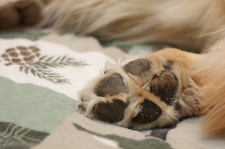How do a dog's paws withstand the cold and snow? Science has the answer

flickr photo by pmarkham
Minding your pets comfort in the winter is important, right?
In weeks past, this premise has been the focus of at least a couple of posts that I've written, and with even a little effort and mindfulness, it's easy to keep your pets comfortable.
One post in particular — protecting a dog's paws with booties while they're outdoors — prompted a bit of discussion, and one very good question was posed to me on Facebook:
"I'm a huge believer in protecting dog paws and had a set of these — until I went to pick up poop with rubber gloves on and my fingers almost froze off. Ever since then, I don't use them because the rubber seemed to conduct the cold exponentially. Obviously dog paws are not the same as human fingers, but I'd imagine the cold conduction would be the same. What are your thoughts?"
The same thought had crossed my mind when it came to using rubber dog booties, which are my preference for good reason: they protect paws from the elements (crusty snow, salt, ice melter).
But in gauging each dog's behavior during and after our outdoor adventures, there was no indication that they were experiencing any discomfort from the cold, and now, we know why.
Researchers in Japan discovered that our furry friend's paws are very special.
To begin with, dogs' pads contain lots of fatty tissue. This area doesn't freeze as easily as other tissues, and the blood vessels in dogs' feet are arranged in a way that's unique: they let them serve as living heat exchangers — arteries in the paws are very close to networks of tiny veins, and these allow the transfer of heat from venous to arterial blood.
The research was conducted by Dr. Hiroysho Ninomiya and other scientists at Tokyo's Yamazaki Gakuen University. An electron microscope and four subjects were used to help do the study, which was published in the journal Veterinary Dermatology.
A "counter-current" heat exchange occurs like this: a paw is cooled by contact with frozen ground, and warmth from the arteries in the paw gets transferred to the tiny veins, called "venules." This helps keep the paw at a manageable temperature. It also warms the blood before it flows back to the body, which helps keep the dog's body temperature from falling too low.
This isn't an ability that nature has given to canines only. Other animals, like penguins and foxes, have it, too.
The information in the study suggests that dogs may have evolved in cold environments, but this doesn't mean that they should be left out in the cold, by any means. They still need protection and care.
Lorrie Shaw is lead pets blogger on AnnArbor.com and owner of Professional Pet Sitting. Follow her pet adventures on Twitter.


Comments
BHarding
Sat, Jan 21, 2012 : 4:14 a.m.
My dogs are fine running around in freezing ice and snow. It's the SALT that cripples them. It cuts into their pads and viola! it rubs salt in the wound. I stay away from salted walks. I feel so sorry for dogs whose owners insist on dragging them down the sidewalks.
Ann English
Sun, Jan 22, 2012 : 8:43 p.m.
If one stays away from salted walks, ice treads are more necessary to wear; strap them on over your boots. People fall further than dogs do on ice; when I had dogs, two of them did fall down on icy spots in the driveway. Neither one got hurt from falling; one a terrier, the other a labrador.
Lorrie Shaw
Sat, Jan 21, 2012 : 3:32 p.m.
BHarding: As a dog walker, I can totally relate. It's so hard, you don't have any control over what others use on their walkways, and some of those chemicals are quite toxic. Kudos to you for being so mindful! I appreciate you reading!
Ann English
Fri, Jan 20, 2012 : 11:42 p.m.
I see the wisdom of dogs' Creator in these scientific discoveries; dogs, foxes and penguins created just right for their post-Flood world, hundreds if not thousands of years before the Flood came, wiping out the subtropical climate all over the earth.
Spencer Thomas
Thu, Jan 19, 2012 : 3:58 p.m.
My dog starts complaining about cold feet around zero degrees (F). He's happy to go walking when it's 5 out, but when it's -5, he starts lifting his paws and whining. We have booties to protect his paws from salt, grit and ice accumulation. They also help on those really cold days.
Lorrie Shaw
Sat, Jan 21, 2012 : 3:30 p.m.
I'm glad that you use them, Spencer! That salt is a bugger. Thanks for sharing your experience!